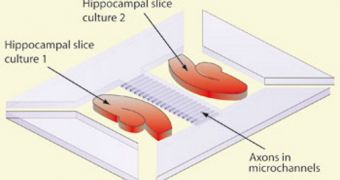Scientists at the Harvard Medical School, in Cambridge, announce the development of a new type of in-vitro microfluidic device (a lab-on-a-chip) that could be used to gauge the development of epilepsy in the near future. The work, which was led by expert Kevin Staley and his team, holds great promise for gaining new insight into how the disease affects the human brain. What the group is planning to do is basically develop a new method of understanding how synaptic circuits form inside the cortex, Chemistry World reveals.
The human brain is arguably the most advanced construct in nature. It features billions upon billions of nerve cells called neurons, all of which are connected to each other via small structures called synapses. These synapses form between the dendrites and axons of neurons, and their study may lead researchers to a new approach on treating a variety of mental illnesses. The new microfluidic device developed at HMS is meant to study how synapses appear and, more importantly, how they are affected by drugs. The need for the in-vitro instrument appeared because portions of the neural network couldn't be accurately controlled in live studies.
With the lab-on-a-chip, brain slices can be grown in cultures, separate from each other. However, the device features very tiny channels, which allow axons to grow through, and connect the various slices to each other. In this highly controlled setup, scientists will then expose the slices to various types of drugs, so as to analyze the influence that the chemicals have on synapses and neural activity. “We decided to use microfluidic [devices] because this technology allowed us to create micro-sized axon conduits and confine drugs to appropriate compartments on the culture chip,” the team leader explains.
One of the cases that will receive most attention, the group reveals, is the excessive connectivity that sometimes appears between nerve cells. Such an excess is widely believed to be the root cause of epilepsy, so the investigators will spend a lot of time looking into this. However, a large number of brain disorders will be covered by the study. “It's [a] very nice effort and can go in many directions,” Pierre and Marie Curie University mechanism of epilepsy expert Richard Miles says of the HMS study.

 14 DAY TRIAL //
14 DAY TRIAL //